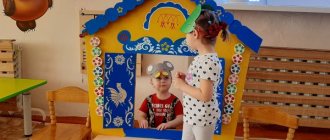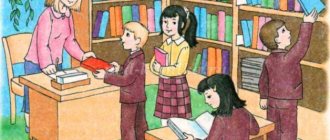GCD "In a forest clearing"
Integration : Artistic and aesthetic development, cognitive development, speech development, social and communicative development.
Tasks:
- Strengthen the ability to correlate the artistic image and means of expression, select material for independent artistic activity, and skills in visual arts. (Artistic and aesthetic development.);
- To consolidate knowledge about the food chain in nature, to form an idea of the rules of behavior in the forest (Cognitive development.);
- Activate and replenish children’s vocabulary, form connected speech (Speech development.);
- To form the foundations of environmental culture and safe behavior in nature.
Material: Silhouettes of birds (tit, woodpecker, sparrow) and wild animals. hard and soft brushes for each child, glue, plasticine, paper and salted colored dough, pieces of torn colored (brown, orange) paper, finely chopped colored wool thread (brown, orange and white), napkin - for each child.
Methods and techniques:
Verbal: Questions for children, explanations, instructions, pedagogical assessment.
Visual: Looking at bird silhouettes.
Practical: Simulation.
Preliminary work . Bird watching on a walk; games; viewing illustrations; reading poems, learning theme songs.
Logic of continuous educational activities
The teacher draws the children’s attention to a “magpie” (made of paper) that has flown into the group.
Educator : Guys, look, a magpie has flown to us. She seems to be alarmed about something and calls us to follow her. Let's go get her.
(The bird takes the children to the “forest clearing.”)
Educator: Guys, look, the bird led us to a forest clearing. But something is wrong with the clearing. What do you think?
Children: There are no forest inhabitants visible in the clearing: wild animals and birds.
Educator: Guys, what animals and birds could you see in the clearing?
Children: Wolf, fox, hare, wild boar, elk, squirrel, titmouse, swallow, sparrow, starling.
Educator: Let's ask the magpie what happened? Where have the forest abodes gone?
(A recording of a chirping magpie sounds.)
Educator: Guys, the magpie said that tourists visited the forest. They violated the rules of behavior in the forest, and therefore wild animals and birds left their homes: some nests, some burrows, and some their lair). Guys, we need to tell people about the rules of behavior in the forest, in nature.
(The teacher invites the children to each take a sign reminding them of the rules of behavior in the forest and talk about it.)
Children: This sign prohibits destroying nests.
This sign prohibits making a fire in the forest.
This sign prohibits cutting down trees.
This sign prohibits throwing trash in the forest.
This sign prohibits playing music and making noise in the forest.
This sign prohibits unnecessary tearing of plants in the forest.
This sign prohibits taking dogs into the forest in the spring and early summer, when animals breed, since dogs instinctively destroy nests and destroy baby animals.
This sign prohibits catching beautiful butterflies and insects.
This sign prohibits catching and taking home wild animals.
Educator: Guys, let's correct the mistake that people made.
(The teacher invites the children to make forest inhabitants from the material for creative work and populate the clearing with them. The child himself chooses the material for the creative activity and the methods for making it. In the process of creative activity, the teacher monitors the quality of the craft, if necessary, uses the techniques necessary to achieve the intended goal child's activities.)
Educator: Guys, place predatory wild animals to the left of the tree, and herbivorous wild animals to the right of the tree.
If any of the wild animals is not completed, then the teacher should say the following:
Educator: Guys, what wild animal is missing from the forest clearing?
Children: The hare is missing.
Educator: Guys, we will definitely choose the time and make a hare, because if we exclude it from nature, what could happen?
Children: We can disrupt the food chain in nature.
Educator: That’s right, and this could lead to an environmental disaster: animals will die of hunger.
(A magpie chirps, the teacher tells the children that the bird thanks the children for saving nature, that now it will not be lonely, and the entire bird choir gives the children their cheerful trill.)



